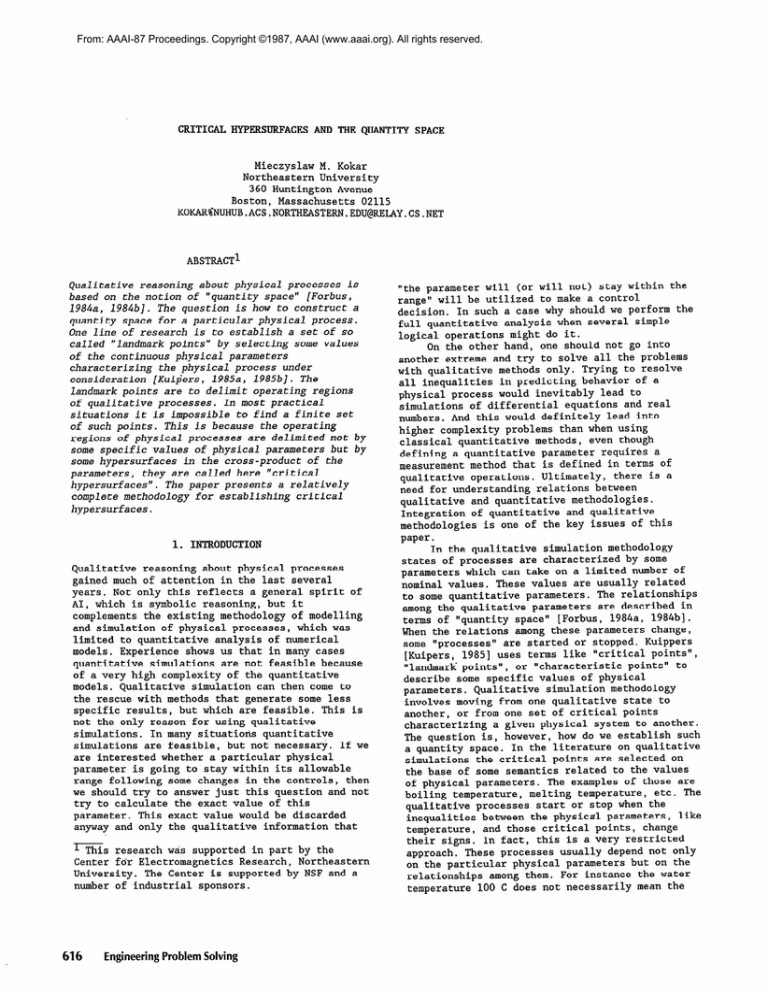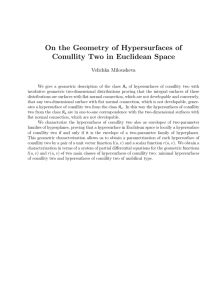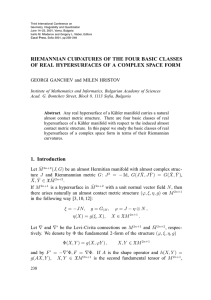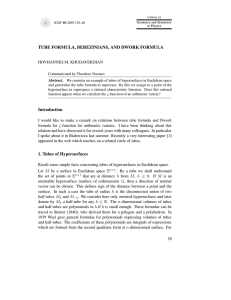
From: AAAI-87 Proceedings. Copyright ©1987, AAAI (www.aaai.org). All rights reserved.
CRITICAL
HYPERSURFACES
AND THE QUANTITY
SPACE
Mieczyslaw M. Kokar
Northeastern University
360 Huntington Avenue
Boston, Massachusetts
02115
KOKAR&WHUB.ACS.NORTHEASTERN.EDU@RELAY.CS.NET
ABSTRACT1
Qualitative reasoning about physical processes is
based on the notion of "quantity space" [Forbus,
1984a, 1984b]. The question is how to construct a
quantity space for a particular physical process.
One line of research is to establish a set of so
called "landmark points" by selecting some values
of the continuous physical parameters
characterizing
the physical process under
consideration
[Kuip'ers, 1985a, 1985b]. The
landmark points are to delimit operating regions
of qualitative processes. In most practical
situations it is impossible to find a finite set
of such points. This is because the operating
regions of physical processes are delimited not by
some specific values of physical parameters but by
some hypersurfaces
in the cross-product
of the
parameters,
they are called here "critical
The paper presents a relatively
hypersurfaces".
complete methodology for establishing critical
hypersurfaces.
1. INTRODUCTION
Qualitative reasoning about physical processes
gained much of attention in the last several
years. Not only this reflects a general spirit of
AI, which is symbolic reasoning, but it
complements the existing methodology
of modelling
and simulation of physical processes, which was
limited to quantitative
analysis of numerical
models. Experience shows us that in many cases
quantitative simulations are not feasible because
of a very high complexity of the quantitative
models. Qualitative
simulation can then come to
the rescue with methods that generate some less
specific results, but which are feasible. This is
not the only reason for using qualitative
simulations. In many situations quantitative
simulations are feasible, but not necessary. If we
are interested whether a particular physical
parameter is going to stay within its allowable
range following some changes in the controls, then
we should try to answer just this question and not
try to calculate the exact value of this
parameter. This exact value would be discarded
anyway and only the qualitative
information that
616
Engineering Problem Solving
"the parameter will (or will not) stay within the
range Itwill be utilized to make a control
decision. In such a case why should we perform the
full quantitative
analysis when several simple
logical operations might do it.
On the other hand, one should not go into
another extreme and try to solve all the problems
with qualitative methods only. Trying to resolve
all inequalities
in predicting behavior of a
physical process would inevitably lead to
simulations of differential
equations and real
numbers. And this would definitely lead into
higher complexity problems than when using
classical quantitative methods, even though
defining a quantitative parameter requires a
measurement method that is defined in terms of
qualitative operations. Ultimately,
there is a
need for understanding
relations between
qualitative and quantitative
methodologies.
Integration of quantitative
and qualitative
methodologies
is one of the key issues of this
paper.
In the qualitative simulation methodology
states of processes are characterized
by some
parameters which can take on a limited number of
nominal values. These values are usually related
to some quantitative
parameters. The relationships
among the qualitative parameters are described in
terms of "quantity space" [Forbus, 1984a, 1984b],
When the relations among these parameters change,
some nprocessesn are started or stopped. Kuippers
[Kuipers, 19851 uses terms like "critical points",
points" to
"landmark points", or "characteristic
describe some specific values of physical
parameters. Qualitative
simulation methodology
involves moving from one qualitative state to
another, or from one set of critical points
characterizing
a given physical system to another.
The question is, however, how do we establish such
a quantity space. In the literature on qualitative
simulations the critical points are selected on
the base of some semantics related to the values
of physical parameters. The examples of those are
boiling temperature, melting temperature, etc. The
qualitative processes start or stop when the
inequalities between the physical parameters, like
temperature, and those critical points, change
their signs. In fact, this is a very restricted
approach. These processes usually depend not only
on the particular physical parameters but on the
relationships
among them. For instance the water
temperature 100 C does not necessarily mean the
water is boiling, it depends what is the pressure,
too. Therefore, to be able to predict the behavior
of a process we need to know not the critical
points of the physical parameters, but the sets of
points fulfilling a specific constraint. We will
A more
call these sets "critical hypersurfaces".
precise definition of critical hypersurface will
be given in Section 2. Intuitively, a critical
hypersurface will be understood as a subset in a
cross-product
of continuous physical parameters. A
critical hypersurface
constitutes a "distributed
landmark". The position of a particular state with
respect to such hypersurfaces
determines whether a
particular process is active or not.
Given a description of a physical process and
a semantics for qualitative reasoning, one can
establish critical hypersurfaces
in many ways. For
instance, one can use differential
equations for
this purpose (provided such models are available).
Another possibilty is to try finding the critical
hypersurfaces
experimentally.
This would involve
an amount of effort far beyond the advantages from
the qualitative simulation. This paper presents a
methodology for finding critical hypersurfaces
which does not require such strong models as
differential equations. This methodology
is based
on the theory of dimensional analysis.
Critical hypersurfaces
can be utilized in a
similar way critical points are used in
qualitative simulations. This problem is beyond
the scope of this paper.
2. CRITICAL
HYPERSURFACES
vs. CRITICAL, POINTS
In this section we show an example of a physical
process in which the notion of critical
hypersurfaces
plays a significant role. Then we
formally define this notion.
As the example we consider the process of
viscous fluid flow in a pipe. It is a known fact
in fluid mechanics ([Young, 19641, [Monin and
Yaglom, 19731) that the flow can be in one of at
least three different qualitative states: laminar,
turbulent, or transitional
(unstable). In each of
these states the process of fluid flow is
described by qualitatively
different mathematical
models. Intuitively, the flow is laminar for small
velocities,
turbulent for large, and transitional
for some interval of velocity in between.
Therefore, one could try to find two critical
velocities, vl, and v2, delimiting the three flow
regions. Unfortunately,
this can work only for a
very limited range of situations, namely when the
pipe diameter D, fluid density p, and fluid
viscosity q, are constant. For instance, for
water in room temperature
in a l-cm-diameter pipe,
turbulent flow occurs above about 0.2 m/s, while
for air the critical speed is of the order of 4.0
m/s [Young, 19641. Thus the critical velocity in
the latter case is 20 times higher than in the
former one. This clearly shows that to reason
about qualitative states of physical processes one
cannot restrict the set of notions to critical
points only.
In hydromechanics
the transition from laminar
to turbulent flow is characterized
in terms of so
called "Reynolds number". Reynolds number (usually
described as R) is defined as a function of the
above referenced parameters of density p,
average velocity v, pipe diameter D, and viscosity
q as:
R = p-v-D/~.
It is found experimentally
that laminar flow
occurs whenever R is less than about 2000. When R
is greater than about 3000, the flow is nearly
always turbulent, and in the region between 2000
and 3000 the flaw is unstable, changing from one
form of flow to the other (here we call it
"transitional").
The relationships
R = 2000
and
R - 3000
describe two hypersurfaces
in the space
defined by the cross-product
of the continuous
parameters p, v, D, and 7. The two
hypersurfaces
divide the space into three
operational regions: laminar, turbulent and
transitional.
This example shows that critical
hypersurfaces
play an important role in
qualitative reasoning about physical processes.
There are however three major problems with this
approach:
- how to know which physical parameters
should be considered in the search for
critical hypersurfaces,
- how to know what kind of relationships
should be taken into account in the search
for critical hypersurfaces,
- how to determine what are the critical
points of the function that describes
critical hypersurfaces
(for instance, how
do we know that the critical values of R
are 2000 and 3000).
These three problems will be referenced to as
the complete relevance problem, the relationship
problem, and the semantics problem respectively.
They are discussed in the following sections.
3. SEMANTICS
OF CRITICAL
HYPERSURFACES
In this section we concentrate on the third of the
problems listed in Section 2. Assume for a while
that we know both the parameters and the form of
the relationship
that describes the hypersurfaces.
We need to find a set of critical points of the
function describing the relationship.
In the literature on qualitative reasoning
there are known several semanics rules: sign
semantics, derivatives semantics [deKleer and
Brown, 19821, [Forbus, 1984a, 1984b], Kuipers'
QSIM semantics [Kuipers, 1985a, 1985b], order of
magnitude semantics [Raiman, 19861. For the
example presented in the previous section none of
these seem to be right. Neither Reynolds number R
or its derivative change their directions of
growth but flow changes from laminar to turbulent.
Therefore some other approach is required.
Kokar
617
One possibility
is to find a relationship
between a parameter, like Reynolds number, and
some observable qualitative parameter for which
the semantics of qualitative
states is explicit.
In our example the character of flow (laminar,
turbulent, or transitional)
can be determined by
directly observing the profile of the speed of
flow. As a matter of fact, that is how the
relationship defining Reynolds number has been
discovered. The bad side of this approach is that
the semantics is specific to a particular physical
process. It is hard to apply this approach as a
general method.
Another approach would be to find a
continuous physical parameter functionally
dependent on the value of the function defining
for which we can utilize one of
the hypersurfaces,
the general semantics for qualitative states
(signs, derivatives,
or orders of magnitudes).
Once critical points have been established for the
new parameter we can transform them to the
critical points of the value of the function
defining the hypersurfaces.
In the case of
critical points of Reynolds number we could
utilize the dependency of the rate of heat
transfer on Reynolds number. It is a known fact
that the rate of heat transfer from/to the liquid
in a pipe to/from the outside strongly depends on
Reynolds number, it is much more intensive for R >
3000 than for R < 2000. If we take the heat
exchange rate as an indicator then we can utilize,
for instance, the semantics of sign of derivative,
or we can apply Kuipers' semantics to the
derivative of the heat transfer rate.
In all of these cases we suggested to use a
parameter which depends on the value of function
characterizing
hypersurfaces.
The choice of the
parameter depends on which process we are
interested in. When we were interested in fluid
flow, we took the speed profile. In the second
example our attention was concentrated
on heat
transfer, or more precisely, on the rate of heat
transfer. Therefore we selected the characteristic
parameter for this process. This seems to be a
reasonable methodology.
Mathematically,
we are looking for a
hypersurface
in the cross-product
of some
parameters xl, . . . . xm, described as
f(x1, . ..) xm) = c.
A critical hypersurface
is defined by fixing
the value of C. If we are interested in a
parameter 2, which depends on C, i.e., Z - g(C),
and if we have some semantics (critical points)
for Z, then we can determine critical points for c
by applying the inverse of the-dependency
g to the
critical points. In our example, Z represents the
heat transfer rate and C represents Reynolds
number. If we are able to determine some critical
points for the heat exchange rate, then we can
transfer them onto Reynolds number.
4. THE RELATIONSHIP
PROBLEM
In this section we concentrate on the forms of the
relationships
that describe critical
hypersurfaces.
We assume now that all the relevant
physical parameters are known, the question is bow
to combine them into a formula that defines a
618
fngineering Problem Solving
critical hypersurface
in the cross-product
of the
parameters.
The interpretation
of critical hypersurfaces
is such that they describe boundaries between two
regions of qualitatively
different behaviors of a
physical system. In other words, the physical
system behaves similarly within the region, even
though the quantitative
parameters characterizing
the system take on different values for different
points within the region.
Similar behaviors of physical systems are the
subject of the similarity
(or similitude) theory
(eg., EBirkhoff, 19601, [Drobot, 19531). The
similarity theory gives rules for combining
physical parameters into monomials called
similarity numbers (similarity modules,
dimensionless numbers). A physical system is
characterized by one or more similarity numbers.
Iwo States Of a system are called similar if all
the similarity numbers for the two states are
equal. The Reynolds number referenced in previous
sections is one example of such a similarity
number. It characterizes
the process of flow of
liquids. A set of states for which all the
similarity numbers are equal is a hypersurface.
The cross-product
of physical parameters
describing a particular process is subdivided by
the relation of similarity into classes
We are concerned only with some
(hypersurfaces).
special of the classes, the ones that we call
critical hypersurfaces.
In this paper we present a method for
determining similarity numbers from only the
knowledge of physical parameters Uniquely
characterizing
the process, and their dimensions.
Ihe rules for doing this are given by the theory
of dimensional analysis ([Birkhoff, 19601,
[Drobot, 19531, [Whitney, 19681).
In order to figure out the forms of
similarity numbers one needs to analyze dimensions
of all physical parameters involved. Dimensions
are expressed in terms of units of measure and
exponents, eg., 5kglm2sm2. A number of physical
parameters from the set of relevant parameters for
the particular process are chosen as SO called
"dimensional base". A dimensional base can consist
of at most as many parameters as many units of
measure are used (mostly three). A set of
parameters can constitute a dimensional base if
the determinant of the exponents' matrix for these
parameters is not null. Usually several subsets of
the parameters involved satisfy this condition.
After selecting a base we take each parameter and
combine it with the base by multiplying
or
dividing it by elements of the base raised to a
real-number-power.
Those powers are selected in
such a way that the resulting monomial is
This procedure is repeated for each
dimensionless.
parameter not in the dimensional base, which means
that we can generate as many similarity numbers as
many parameters remain in the set after removing
from it the ones that constitute the base.
In our example the relevant parameters are
expressed in terms of units ofomTssl(kg),
length
and time (s) as: v-xvkgms'
, ol=
~~;lm-ls-l
P = xpkglm-3s0,
D - xDkgOmlSO.
and XD represent
T!e numbers'x,, x0, x
numerical scales of tR'e particular parameters.
Suppose P, rl, and D have been selected as
dimensional base. It can be done because the
determinant of the following matrix of exponents
is not null:
1 -3
0
1 -1 -1
010
The remaining parameter, v, can be combined
with the base into a dimensionless
monomial in the
following way:
~.pl.&~+
In more difficult cases the list of the
relevant parameters is not readily available, or
at least the experts in the given field cannot
come to a cosensus on this. The approach in such
cases consists of listing all the suspected
hypothetical parameters as the candidates,
Note that this is the only possible
combination of the exponents, given a dimensional
base. This is how we derive the functional formula
that represents Reynolds number. Selecting a
different dimensional base would result in a
little different formula. Fortunately,
for the
purpose of similarity it does not really matter
which base has been chosen. The states that are
similar in one dimensional base remain similar in
any other base that we choose. More formally it is
expressed as: similarity of the states of a
physical process is invariant with respect to the
choice of dimensional base.
5. THE COHS?LETE RELEVANCE
I'ROBLEM
The last main problem with establishing
a set of
critical hypersurfaces
is how to determine all
relevant physical parameters characterizing
a
given physical phenomenon. This seems to be the
most difficult problem. This problem is beyond the
scope of qualttative
simulations. But it is
closely related to qualitative reasoning as it is
one of the steps that lead to establishing
operating regions for qualitative processes. This
problem has been intensively investigated in
modelling and simulation, in systems science, and
in the area of artificial intelligence as well.
In any approach to this problem one must
accept some kind of a "closed world assumption".
In this paper we take a goal-oriented
approach in
which the closed world assumption is closely
related to the goal of the process under
consideration.
This is manifested
in the way of
selecting the relevant parameters: only those
parameters are selected which can uniquely
determine the value of the parameter that
characterizes behavior of the system.
Mathematically,
we are looking for a functional
dependency between a parameter explicitly chosen
as a characteristic
of the behavior of the system
and a set of the arguments of this function. The
set of parameters that satisfy the requirement of
functionality will be complete set of relevant
parameters.
Essentially,
there are three main ways of
determining what are the relevant parameters for a
given physical process. One of them is the
existing knowledge of the process being modelled.
In many cases this knowledge is available, all the
relevant parameters can be listed by experts in
the given field, the only problem is the
qualitative analysis of the possible behaviors of
the process.
6. A
RR MIR ESTABLISHING
HYIXRSURFACES
cltITIcAL
In this section we summarize the results of the
previous three sections by descrllbing several
steps in which critical hypersurfaces
can be
established.
1. Determine the characteristic
parameter
(goal parameter, output parameter,
dependent parameter) of the process which
is to be modelled.
2. Determine what are the parameters known to
be relevant to this particular
characteristic
parameter. Use some expert
knowledge to this aim.
3. Collect some experimental data measurements
of the characteristic
parameter for a number of combinations of
values of the relevant parameters.
4. Analyze completeness
of the set of
relevant parameters.
If the completeness
condition is fulfilled then analyze
redundancy of some of the parameters.
Kokar
619
5. If the set of parameters is not complete
then use one of the methods for generating
descriptions
of relevant parameters.
6. Using methods of dimensional analysis
derive a set of similarity numbers as
functions of the physical parameters.
7. Using one of the available semantics
determine
(e.g., signs of derivatives)
critical values of the derived functions.
8. The expressions equating the monomials
representing
the similarity numbers with
the critical values constitute
descriptions
of the critical
hypersurfaces.
7. CONCLUSIONS
One of the most important problems in qualitative
reasoning is how to establish an appropriate
quantity space to conduct the simulations in, or
in other words, how to establish operating regions
for qualitative processes. One possible way is to
apply some semantics to quantitative parameters
characterizing
the physical system under
consideration,
resulting in a set of critical
points for every physical parameter involved. A
set of critical points is applicable for some
limited situations only, namely when some relevant
parameters remain constant. The objective of this
paper is to extend this approach to a wider domain
of situations, such that would account for
variability of all relevant parameters. The
generalization
of the methodology
is achieved
through introduction of the notion of critical
hypersurfaces
in place of critical points. These
critical hypersurfaces
delimit operating regions
of qualitative processes. The paper presents a
relatively complete methodology
for finding
critical hypersurfaces.
The methodology
is based
on the theory of dimensional analysis. A part of
this methodology
is implemented in the system for
discovery of physical parameters, called COPER.
[Forbus, 1984b] Forbus, K., D. Qualitative
Process
Theory. Technical Report, 789, MIT
Artificial Intelligence Laboratory, 1984.
[Forbus, 19861 Forbus, K., D. Interpreting
measurements
of physical systems.
Proceedings
of AAAI-86, Fifth National
Conference on Artificial Intelligence,
Philadelphia,
113-117, 1986.
[Kokar, 1986a] Kokar, M., M. Determining Arguments
of Invariant Functional Descriptions.
Machine Learning, 1, 1986.
[Kokar, 1986b] Kokar, M., M. Discovering
functional formulas through changing
representation
base. Proceedings of the
Fifth National Conference on Artificial
Intelligence,
Philadelphia,
PA, 1986.
[Kuipers, 1985a] Kuipers, B., J. Qualitative
Simulation of Mechanisms. MIT Laboratory
for Computer Science, TM-274, Cambridge,
iiA; 1983.
[Kuipers, 1985b] Kuipers, B., J. The Limits of
Oualitative
Simulation. Proceedings of
the Ninth Joint Conference on Artificial
128-136,
Intelligence.
Los Angeles:
1985.
[Langley, P. 19811 Langley, P. Data Driven
Discovery of Physical Laws Cognitive
Science, 5, 31-54, 1981.
[Monin and Yaglom, 19733 Monin, A., S., and
Yaglom, A., M. Statistical Fluid
Mechanics: Mechanincs of Turbulence. The
MIT Press, Cambridge, MA, and London,
England, 1973.
[Raiman, 19861 Raiman, 0. Order of Magnitude
Reasoning. Proceedings
of the National
Conference on Artificial Intelligence,
Philadelphia,
PA, 100-104, 1986.
[Whitney, 19681 Whitney, H. The Mathematics
of
Physical Quantities,
part I and II.
American Mathematical
Monthly, pp.
115-138 and 227-256, 1968.
[Young, 19641 Young, H., D. Fundamentals
of
x-----
Mechanics and Heat. Second Edition,
McGraw-Hill
Book Company, 1964.
[Birkhoff, 19601 Birkhoff, G. Hydrodynamics.
A study in logic, fact and similitude.
Princeton University Press, Princeton, 1960.
[deKleer and Brown, 19821 deKleer, J., Brown, S.
Foundations of Envisioning. Proceedings
of the National Conference on Artificial
Intelligence AAAI-82, 209-212, 1982.
[Drobot, 19531 Drobot, S. On the foundations of
dimensional' analysis. Studia
Mathematics,
14, 84 - 89, 1953.
[Falkenhainer and Michalski, 19861 Falkenhainer,
B. and Michalski, R., S. Integrating
quantitative
and qualitative discovery: The
ABACUS system. Machine Learning, 4,
1986.
[Forbus, 1984a] Forbus, K., D. Qualitative Process
Theory. Artificial Intelligence,
24, 85-168, 1984.
620
Engineering Problem Solving







